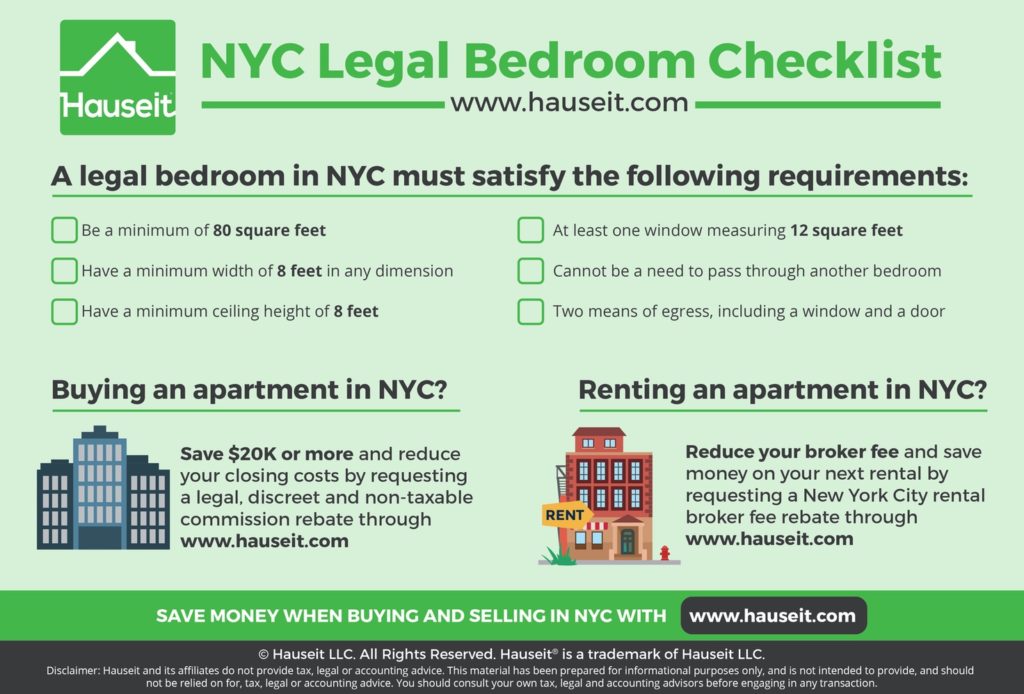A legal bedroom in NYC must have minimum dimensions of 8 feet on either side, including a minimum ceiling height of 8 feet and must be at least 80 square feet in size.
Furthermore, a legal bedroom must have at least two forms of egress, one of them being a window no smaller than 12 square feet.
For a bedroom to be considered legal, it must be possible to access a bathroom without having to pass through any other bedroom.
NYC real estate agents are notorious for stretching the truth, especially when determining what rooms qualify as legal bedroom in New York City. In this article, we’ll explain the requirements of a legal bedroom in NYC in detail.
We’ll also dispel false truths about legal bedrooms in NYC, such as the myth that all bedrooms must have a closet.
Table of Contents:
For a bedroom to be considered legal in NYC, it must satisfy the following requirements:
-
Be a minimum of 80 square feet
-
Have a minimum width of 8 feet in any dimension
-
Have a minimum ceiling height of 8 feet
-
At least one window measuring no less than twelve square feet
-
There cannot be a need to pass through any other bedroom in order to access the bedroom
-
Two means of egress, including a window and a door that can be opened from the inside
There are a few exceptions to the requirements above, which include:
-
If the apartment has three or more bedrooms, one-half of the bedrooms may have a minimum dimension of 7 feet.
-
If the bedroom is in a basement or on the top floor of a converted dwelling (such as a brownstone with multiple apartments, it must have a minimum ceiling height of 7 feet.
-
If the bedroom has a sloped ceiling, there must be a clear ceiling height of 7 feet over at least 1/3rd of the room.
-
The window cannot be a lot-line window. The window must open onto a street, yard or court on the same lot.
You should also know that a bedroom in NYC is NOT required to have a closet for it to be considered a legal bedroom.
The rules and regulations concerning legal bedrooms in NYC are located in the New York State Multiple Dwelling Law as well as the New York City Administrative Code.
Get a 2% Rebate When You Buy
Save thousands on your home purchase with a buyer agent commission rebate from Hauseit
A windowless bedroom is not considered to be a legal bedroom in NYC.
This is a commonly asked question for buyers who are considering loft units. Many floor-through loft apartments in NYC have a large square footage but very few windows.
Just because there is ample space to modify the floor plan and add rooms does not mean that you will be able to create legal bedrooms.
If you are buying a loft or a lofted apartment, you should leverage the expertise of your buyer’s agent and real estate attorney to have them confirm the current legal configuration of the apartment you are interested in purchasing.
Window regulation for legal bedrooms in NYC is addressed in § 27-2058 of the NYC Administrative Code (excerpts below):
Save 2% On Your Home Purchase
Save thousands on your home purchase with a buyer agent commission rebate from Hauseit
No. Contrary to what you may have heard, bedrooms in NYC are not legally required to have a closet.
However, you should be mindful of whether or not bedrooms (and the apartment altogether) have sufficient closet space. Having poor closet space can make your life difficult while you live there and make it more difficult for you to sell in the future.
If you are considering an apartment with poor closet space, ask yourself the following questions:
-
Does the current floor plan / layout offer an easy way to add more closets?
-
If it’s not possible to add closet space, does the building have storage? If so, is there a a waitlist? How much does storage cost?
If storage space is important for you, ask your buyer’s agent what options are available in the building you are considering.

A seasoned buyer’s broker will know to request the storage unit and bike hanger documentation from the listing agent.
If the building does not have separate documentation regarding storage, the storage policies are likely discussed in the house rules documentation.
The minimum bedroom dimensions in NYC are 8 feet in any dimension with a minimum ceiling height of 8 feet.
A legal bedroom in NYC must have a minimum square footage of 80 feet.
It must also have at least one window measuring no less than twelve square feet.
There are a few exceptions which permit a legal bedroom in NYC to have dimensions less than 8 feet.
These exceptions include the following:
-
One-half the number of bedrooms in a dwelling unit containing three or more bedrooms may have at least minimum dimension of seven feet;
-
A room in a class B multiple dwelling (hotels, boarding schools, etc.) as defined in section four of the multiple dwelling law which may have a minimum floor area of sixty square feet and a least horizontal dimension of six feet.
A Full Service Listing for 1%
Sell your home with a traditional full service listing for just one percent commission.
No. A bedroom is only legal in NYC if you are not required to pass through a different bedroom to access the bedroom.
Furthermore, for a bedroom to be considered legal you must be able to access a water-closet (bathroom) from it without passing through any other bedroom.
Source: New York Multiple Dwelling Law: §82 & §179 **
Get a 2% Rebate When You Buy
Save thousands on your home purchase with a buyer agent commission rebate from Hauseit







Excellent article! This is super important info regarding home value, especially given the current loft craze
Thanks for the info. It may have been included in the legalese for §27-2058, but what about rooms with windows and ample space but below street level? If it opens to a courtyard/garden say in a multi-story coop.
Hi Ezra – great question! A basement in NYC must have at least one-half its height above curb level. The basement would also need to meet all of the requirements for light, air, sanitization and egress in addition to receiving DOB (Department of Buildings) approval for it to be considered legal. As we explained above, the ceiling height in a basement also needs to be at least 7 feet.
Does this answer your question?
Thank you for putting all this information in one place.
What about buildings erected prior to 1929? Are the rules for legal bedrooms different?
I take issue with the comment that “there’s no real downside to renting an illegal bedroom.” With high rents and tight vacancy creates predatory behavior in which landlords/renters are exploiting desperate people without many options. It also impedes any progress towards raising our housing standards to be safe and livable (sorry but sunlight, ventilation, and fire escapes are required for livability), erodes the enforcement of legal standards, and encourages exploitation. NYC has already had a horrific period of slums, and we shouldn’t encourage a return to such conditions.
I heard from a lawyer friend that the duplex condo units in our building which have the lower floor below grade can’t advertise their lower level rooms as legal bedrooms. Even though they have a walk out backyard accessible from the lower level (very common by the way in Lower Manhattan neighborhoods like the West Village, Greenwich Village etc.).
He says the reason is because there’s no fire exit and it’s below grade, so it can’t be legally marketed as a bedroom if it’s on the lower level. Can you confirm?
Can someone show me where an official building code/NYC code/NY code says that a bedroom needs two means of egress? Would really help me if you could
thank you so much for this article.
If the room is an interior room with an interior window that looks into the common space of the apt, would it be considered a legal bedroom? If not, can the landlord be in trouble for advertising it as a legal bedroom?
Is it considered a legal bedroom if its an interior room with a skylight and the proper dimensions?